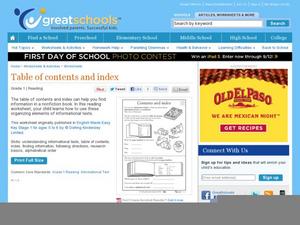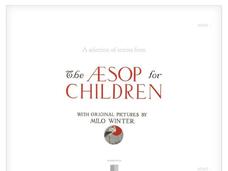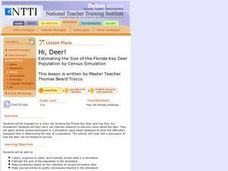Curated OER
Nonfiction Books: Table of Contents and Index
How do you find what you're looking for when reading a nonfiction book? Even first graders can learn how to use a table of contents and an index. They use the provided images of each to locate information and answer nine questions.
Curated OER
Using a Table of Contents
While simple, this resource would be a great way to introduce your class to the use of the Table of Contents. It provides a step-by-step explanation describing how to find information. A teacher could supplement this presentation with...
Curated OER
Contents and Index
It's important for your readers to understand features of informational text such as index and table of contents, so give them this visual activity to get started. They read a brief explanation of informational text, then look at an...
Curated OER
Glossary, Index, and Table of Contents
Fourth graders use two separate sources to learn about index, glossary, and table of contents usage. In this library lesson plan, 4th graders use two books, Learning About Weather with Graphic Organizers, and The World Almanac for Kids,...
Curated OER
Introduce: Comprehension Monitoring using About Trees
As scholars begin reading more difficult text, they need to acquire an arsenal of comprehension strategies. Here are few helpful ones to guide new readers through the informational text About Trees, which is linked here for printing....
Curated OER
Table of Contents and Index
Have your class investigate the use of a table of contents and index to find information. They identify characteristics of informational books and add them to a chart, then demonstrate how to use the index and table of contents by trying...
Curated OER
Researching Lesson 4
Students explore a "table of contents." In this book researching lesson, students identify common elements of a "table of "contents" and complete a worksheet with questions about this topic.
Curated OER
Animal Report (Lesson 5 - Location and Access - Grade 4)
Fourth graders practice finding answers to various questions using the Table of Contents and Index of a sample resource book. They complete a practice worksheet.
Curated OER
Using Informational Books: Index, Table of Contents & Alphabetical Order
Students recall and use previous knowledge of the library's reference and nonfiction sections. Also they utilize various forms of reference (encyclopedias & dictionaries) and nonfiction books.
Curated OER
Reading Predictions
Second graders read and predict content and purpose for table of contents, index, headings, captions, illustrations, and major words from their science or social studies textbooks. They use books' elements to summarize what they can find...
Curated OER
Main Idea in Informational Text
Individuals complete a pre-assessment to gauge their ability to determine the main idea and supporting details in nonfiction text. They examine a new piece of nonfiction reading by looking at the table of contents, headings, and index...
Curated OER
Creating a How To Book
Third graders investigate "How To" books by watching a "How To" video and looking at books in the media center. They make a class "How To" book with a title page, table of contents, individual student pages, and graphics which they make...
Curated OER
Non-Fiction Books
A well-designed presentation on non-fiction books awaits your young readers. They discover the features of a non-fiction book, and are shown the elements of a non-fiction book such as, the table of contents, the glossary, an index, and...
Curated OER
Under the Sea - KWL Chart
Students create a KWL chart to start the discussion on ocean animals. They practice sorting the animals into their different classifications. They use indexes, table of contents and glossary to find information.
Curated OER
School - Home Links: Parts of a Book
Parents or learning partners assist emergent readers with a School-Home Links worksheet. The children complete a matching activity about the parts of a book which include a table of contents, title page, and glossary. They match the word...
Curated OER
Analyzing Textbook Formats
Students explore the characteristics of a non-fiction text. For this comprehension lesson, students are led on a guided tour of each text and identify the features of a non-fiction text. Students continue to practice locating features...
Mark Twain Media
Understanding Informational Text Features
Everything you need to know about informational text features can be found in this resource. Recognizing these types of text features and how they are used in text allows readers to better understand information. Teachers can use this as...
Meadows Center for Preventing Educational Risk, University of Texas at Austin
Lesson 5 - R-Controlled Syllables
Put on your pirate hat and get ready to teach r-controlled syllables. Learners practice using words that contain ar, or, er, ir, and ur. Instructors model how to decode words to isolate vowel teams, as well as combine r-controlled sounds...
Library of Congress
A Selection of Stories from The Æsop for Children
Read and incorporate a variety of Aesop's Fables into a fable genre study with an eBook produced by the Library of Congress. The interactive eBook contains 146 fables written by Aesop and includes colorful interactive illustrations by...
Curated OER
Getting to Know Your Textbook
Eighth graders use the glossary, index, and headings to location information in their textbooks. In this textbooks lesson plan, 8th graders complete discussion questions about the information they can learn from textbook features.
Curated OER
Presidents
Fifth graders locate a biography about their president. They skim the table of contents, index, and opening paragraphs of chapters for any pre-reading clues that correspond to web topics.
Curated OER
Scanning
Pupils examine how to scan textual material. They identify and circle key words, phrases, and synonyms in the table of contents and the index of a classroom text.
Curated OER
Library Skills Review
Middle schoolers review library skills by rotating through teacher-created learning stations covering various topics. They discuss plagiarism, work on Almanac practice as a team, complete practice using indexes, and an abstracts handout...
Curated OER
Hi, Deer!
Students collect, organize by table, and examine census data in a simulation, estimate the size of the population in the simulation and make predictions based on the collection of census simulation data.

























